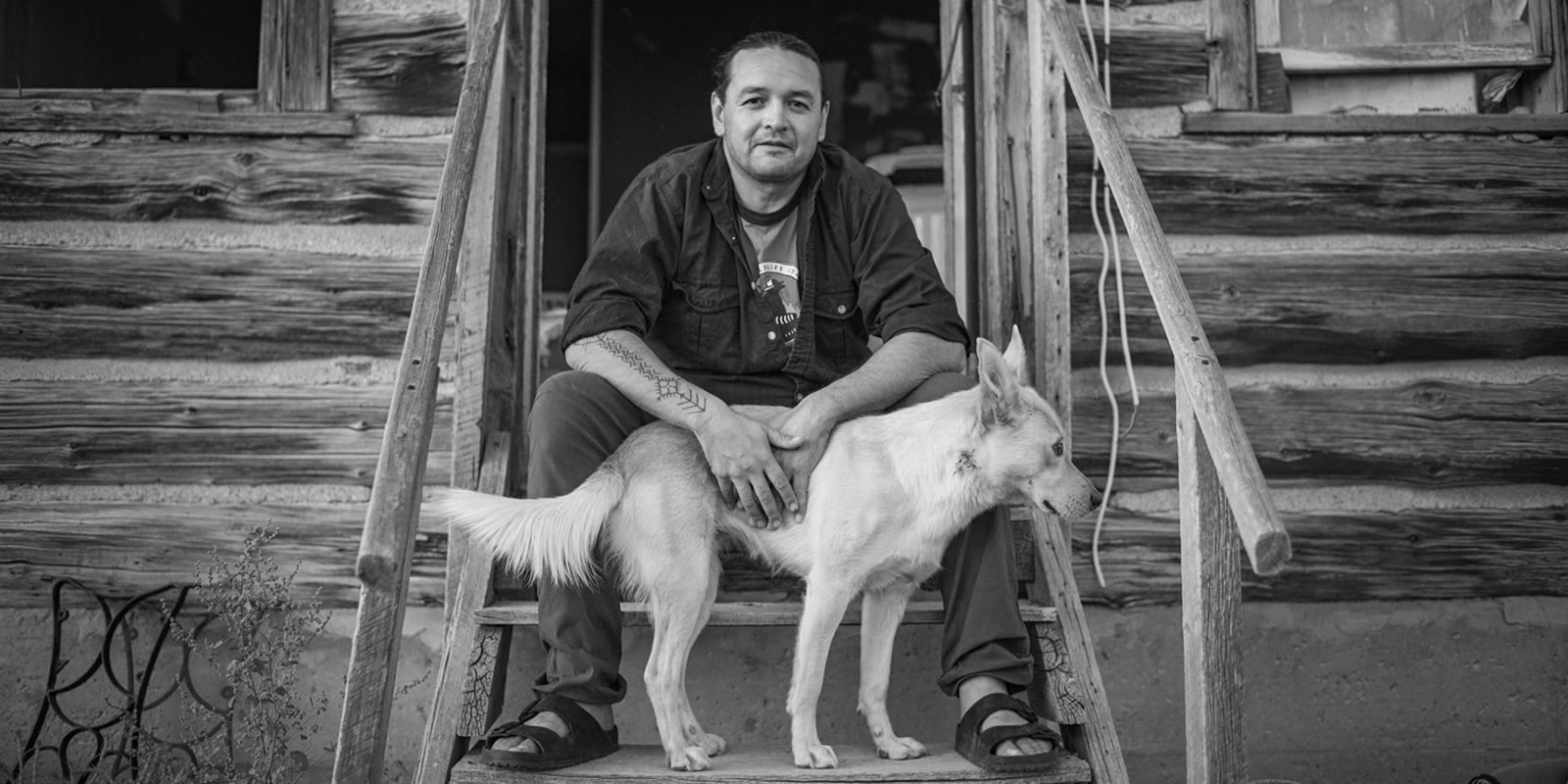This article was originally published by Stephen Lezak of High Country News on December 1, 2021.
On the Wind River Indian Reservation, two animals slip between the cracks of what is wild and what isn’t.
A couple of years ago, Patti Baldes’ phone rang. “Patti? The buffalo are out,” said someone from the Wind River Reservation’s Tribal Fish and Game Office. “Are they yours or are they Jason’s?”
“They’re probably mine,” Baldes recalled saying. Hers, in that they belonged, like she does, to the Northern Arapaho Tribe. Jason Baldes, Patti’s husband, is Eastern Shoshone. The two tribes share the Wind River Indian Reservation in central Wyoming, and each has its own buffalo herd on separate pastures.
By mid-morning, a crowd had gathered along the edge of U.S. Highway 26 to watch the 11 fugitive buffalo. About a dozen teenagers arrived with horses — members of a tribal youth group that teaches horsemanship. The old man in charge of the program instructed his students to smudge with sage as they readied their horses and prepared to herd the buffalo back to their fenced enclosure.
The buffalo had escaped onto land leased for cattle on the northern part of the reservation, where a pair of two-lane highways weaves between foothills, cradling 70,000 unfenced acres of pale Wyoming steppe between them.
“We were secretly just so happy,” Patti Baldes said. “But scared.” Happy, because after years working to restore wild buffalo to the reservation’s open range, they had succeeded. For a tenuous moment, “there were buffalo out there and kids on bareback horses running around.” It had been 135 years since Native people had herded buffalo in the Wind River Valley. “It was the most amazing thing ever.”
But there was also fear. As soon as the buffalo broke free of their enclosure on private property, they entered a jurisdictional no man’s land. The tribal game code, which regulates hunting on the reservation, made no mention of buffalo. “If we didn’t get them in, there’s no way we could protect them,” Jason said. “People could shoot them, and there would be nothing we could do.”
Before the riders approached the buffalo, Jason laid down some ground rules. “I did my best to explain that we needed to keep it low-key and quiet.” Instead, the riders gave chase, and the buffalo took off across the open range. “They were treated like cows,” Patti said. “Like they could be herded.”
“The horses started running,” Jason added. “Pretty soon the buffalo were running all over the place. Cars were following the horses through the sagebrush.”
Jason, sitting at a dining room table with a cup of coffee above and a snoring dog below, spoke soberly about the escape. Standing opposite, Patti offered her own version of events and occasionally smiled, savoring the memory. They share a sense of pride and responsibility: Their work led to the reintroduction of buffalo on the reservation following their near-extirpation by colonists in the late 19th century.
The effort began with a partnership between the two tribes, the National Wildlife Federation and the U.S. Fish and Wildlife Service. Jason led the work wearing two hats; he’s both the National Wildlife Federation’s tribal buffalo coordinator and the Shoshone tribal buffalo representative. In 2016, the first buffalo were given a home in a small enclosure owned by the Shoshone Tribe. Three years later, the Arapaho Tribe acquired its own herd.
The Baldeses’ work is a small part of a larger national effort to restore wild buffalo to tribal lands across the West. (Most scientists prefer the name “bison,” but “buffalo” is more commonly used in Native America.) The Intertribal Buffalo Council, of which Baldes is the secretary, has helped return over 20,000 buffalo to 1 million acres of tribal land. It’s a small fraction of the tens of millions that ranged between Alaska and Mexico at the beginning of the 19th century.
At the end of that first day, exhausted and worried about the buffalo after running them for so long, the riders regrouped at the highway. Someone pulled up in a truck with dinner. “We’re eating plain sandwiches after trying to get the buffalo home,” Patti recalled. “And they are home, which was a feeling I think we both felt: Can’t we just leave them — like, just leave them — right where they are?”
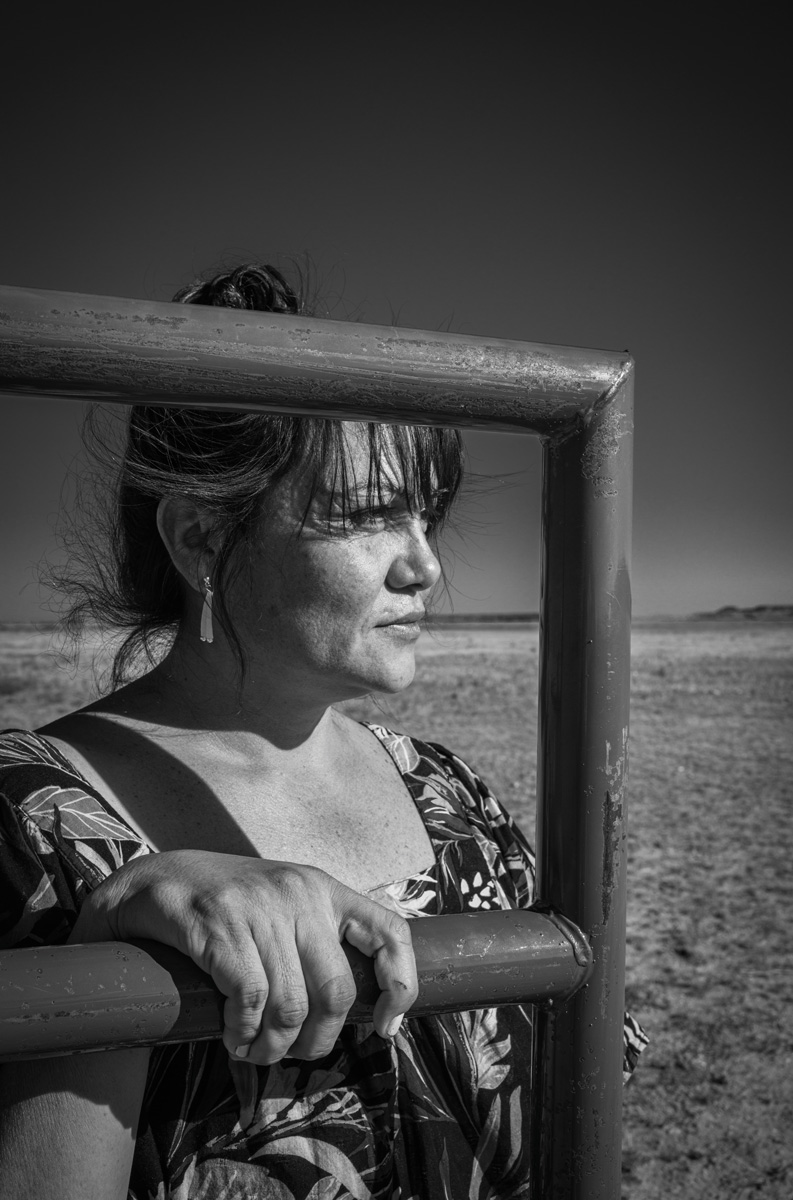
Patti Baldes, a member of the Northern Arapaho Tribe, stands next to the gate of a bison enclosure. Photo by Russel Albert Daniels/High Country News
“And they are home, which was a feeling I think we both felt: Can’t we just leave them — like, just leave them — right where they are?”
The next morning, Patti and Jason gathered a smaller group from around the reservation. The new strategy — fewer riders and a slower pace — seemed to work. Patti’s brother, nephew and another rider went ahead, slowly pushing the reluctant herd. Jason and Patti followed in their truck. They drove across 10 miles of open range before returning the buffalo to their 600-acre pasture — an enclosure less than a square mile in size.
That day’s buffalo drive was a modern inversion of an ancient practice. Just on the far side of the reservation boundary, stone cairns still mark the drive paths at “bison jumps,” where, for thousands of years, Shoshone hunters sent herds of buffalo tumbling over cliff sides and then gathered below to harvest the meat.
On their way back to the enclosure, Jason, Patti and the riders saw dozens of horses watching them from the sagebrush buttes. They were a small fraction of the unknown thousands of free-ranging horses on the reservation — wild or feral, depending on whom you ask. Like the buffalo, they were also fugitives, unsanctioned occupants of tribal land. But unlike the buffalo, no one had any plans to remove them.
Across Indian Country, tribes are working to restore one species and sustainably manage the other. Both buffalo and horses have troubled places in the American West, mirror images of wildness, colonialism and Indigeneity. Two ungulates occupy the same physical territory — but on seemingly different maps. Each testifies to the unresolved questions of what, and who, the West is for.

Geldings at the Wind River Wild Horse Sanctuary near Lander, Wyoming, a privately owned piece of land within reservation boundaries. Its owners contract with the Bureau of Land Management to provide long-term care for 225 wild horses removed from federal rangeland. Photo by Russel Albert Daniels/High Country News
WHEN ASKED HOW MANY WILD HORSES are on the Wind River Reservation, Art Lawson, the Shoshone and Arapaho Fish and Game director, couldn’t say. “We really don’t have a clue,” said Lawson. “We have 2.2 million acres that we cover, and I only have three wardens and two U.S. Fish and Wildlife biologists.” But he thinks 10,000 might be a reasonable estimate: “We’ve got to be close to that.”
Whatever the population is, Lawson says that it’s growing fast, doubling every four years. Now, because of the added grazing pressure, mule deer no longer migrate through the reservation, and bighorn sheep are growing scarce. “There’s no feed — there’s nothing but horse trails,” Lawson said.
To the untrained eye, wild horses are indistinguishable from captive ones. They’re lively, well-fed, and colorful enough to fill out a glossary of horse terms: palominos, roans, sorrels, pintos. They look more comfortable on the open range than the skittish pronghorn antelope loping through the same sagebrush. They gather in small herds of about 10, with a single male orbiting the rest, as if to maintain order. When humans approach, the horses form a neat line, like mismatched dominoes staggered behind the stallion.
They range over vast stretches of unirrigated sagebrush steppe, up to the dense groves of aspen that begin above 7,000 feet. Their watering areas and crisscrossing trails are worn to powder. In places, 4-foot-wide heaps of manure known as “stud piles” mark the stallions’ territorial claims. They’re so numerous now that they rival cattle for the distinction of being the dominant animal in the landscape.
The reservation was established in the 1860s and overseen by the Bureau of Indian Affairs with the goal of assimilating the Eastern Shoshone and Northern Arapaho into farmers and ranchers. This left wildlife to fill out the margins, usually in mountainous terrain or areas with poor access to water. Back then, there was constant pressure from hunters. Now, horses are competing with both wildlife and cattle for the landscape’s limited forage.
With limited rangeland already under pressure, some ranchers worry that setting aside acreage for buffalo implies taking land away from cattle and sheep. Across the West, many have protested buffalo reintroduction on those very grounds. But that’s just one part of the story.
“It’s not too hard to see racism around here,” Jason Baldes told me on the first day we met. He wore his long hair in a thick braid and two rings in each ear. “The last racist slur I got was opening the gate to the buffalo.” Two men drove by, “calling me ‘prairie n****r’ — that kind of crap.” He steered the conversation along, almost dismissively. “This is way bigger than any of those knuckleheads that want to yell at me.”
Although Baldes understands why his work has generated resistance, he’s hardly apologetic about it. “I’m not saying eliminate cattle grazing altogether, but there are places where it shouldn’t be happening.” He sprinted through the history of the Wind River Reservation, beginning with the methodical slaughter of buffalo in the mid-19th century, followed by the sale of the most valuable — water-rich — tribal lands to private buyers. “This notion of taming and domesticating and fencing in, fencing out, plowing up, paving over — in the notion of progress. These undermine the philosophical understanding that Native people had about the interconnectedness of all living beings, about what our role is as stewards.” It’s from that perspective that he said, with a trace of indignation, “Cows are invasive species. Just don’t call them that, because ‘cattle is king’ in Wyoming.”
Baldes’ effort to reintroduce buffalo raises many of the same questions about tribal sovereignty as the effort to deal with a surge in wild horse populations across the West. The European horses brought over by Spanish colonists in the 16th century descended from wild horses that originally lived in North America for millions of years until the end of the last ice age. This history is at the center of wild horse management: Are horses native wildlife, or a feral invasive species?
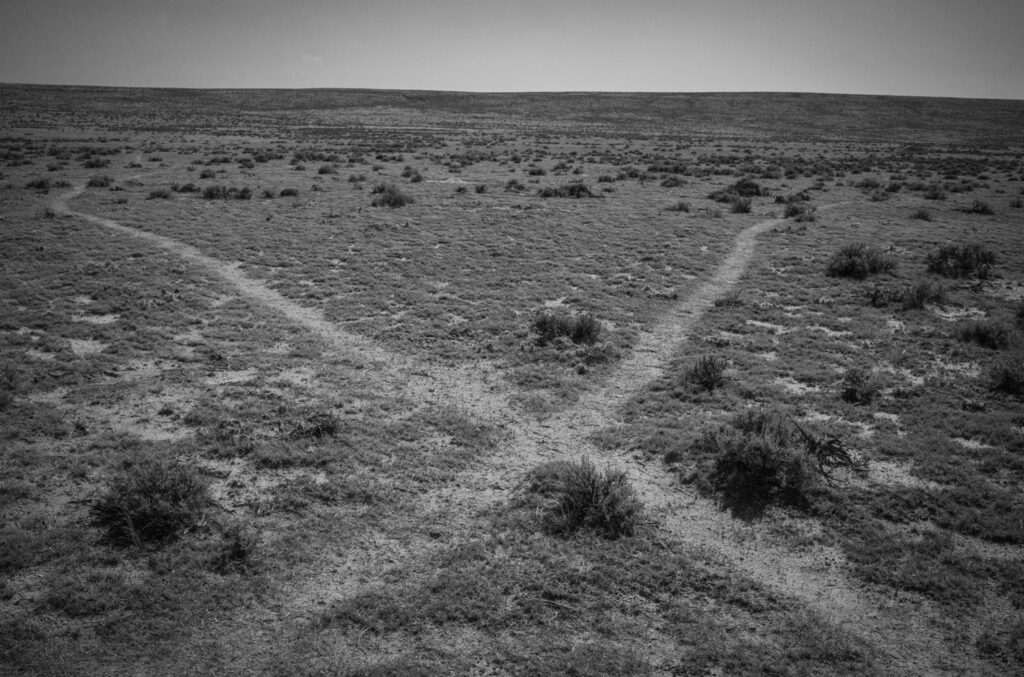
Wild horse trails create a crossroads on the open range of the Wind River Reservation in rural Wyoming. Photo by Russel Albert Daniels/High Country News
By the beginning of the 20th century, an estimated 2 million wild horses roamed the West. By 1971, the population had declined precipitously, with one estimate counting 9,500 horses on federal rangeland. Their near-extirpation — like the buffalo’s — took place as agriculture intensified across the West. Some horses were killed to make room for cattle and sheep, others captured for breeding or use on farms and ranches. Many more were rounded up and sold to slaughterhouses, where they were processed for human consumption abroad or for commercial products like pet food.
“Cows are invasive species. Just don’t call them that, because ‘cattle is king’ in Wyoming.”
In 1971, in response to a wave of national activism, Congress passed a law that criminalized killing wild horses on federal land. In turn, the secretary of the Interior was tasked with managing any populations that grew too large. But beginning in 1988, the secretary’s options for doing so were curtailed. Directives tucked into annual appropriations bills prohibited the Bureau of Land Management from euthanizing healthy animals or selling them for slaughter, directly or indirectly. In 2006, Congress prohibited the U.S. Department of Agriculture from certifying slaughterhouses that processed horsemeat, regardless of whether the horses were wild or livestock. Across the West, wild horse populations began to climb as swiftly as they had once fallen.
In the past 10 years alone, the number of wild horses and burros on federal rangeland has grown from 38,000 to 95,000. The BLM scrambled to manage the problem. Following the prohibition on euthanasia and unconditional sale, the agency hoped that volunteers would adopt the “excess” animals that were removed from overpopulated ranges. But even as the BLM invested more resources into adoption — including a $1,000-per-animal incentive — fewer horses and burros entered private ownership than were removed from public lands.
At the same time, the BLM, in cooperation with well-organized advocacy groups, such as the American Wild Horse Campaign, administered thousands of doses of horse contraception. Trained volunteers with contraceptive dart guns effectively controlled horse populations on some small ranges. But the practicalities involved in darting thousands of mares across tens of thousands of acres — and repeating the process annually — left the BLM and Congress skeptical that this could provide a large-scale solution. In the past five years, the BLM administered just 3,300 doses.
Another fraught experiment in Western land management casts a long shadow over this issue. At the behest of ranchers, hunters and their political and cultural allies, predators such as wolves, bears and cougars have been culled across the West. The few animals allowed to survive were concentrated in national parks, forests and wilderness areas, which have limited overlap with the open ranges favored by wild horses and administered by the BLM. Most of the big game on these landscapes, such as elk and antelope, is kept in check by human predation. That used to be the case for wild horses, too.
The legal counsel for one Western Republican congressman put it this way: “We’ve put the BLM in an impossible position, where we’ve given them a job and we won’t let them do the job.”
That’s the story on federal lands. According to a 2013 statement by the National Congress of American Indians, there are over 100,000 wild horses on tribal lands — more than on all federal lands nationwide.
Across the United States, the BLM’s mandate stops at reservation borders. And while the Bureau of Indian Affairs has a legally binding trust responsibility to protect tribal land, it doesn’t have a standalone program to aid with wild horse management. Instead, it falls to underfunded agencies like Lawson’s, which lack the resources to even count wild horses, let alone manage them. On the Wind River Reservation, Lawson reported that his agency had not received any funding from the BIA for wild horse management since he started his job in 2017. “With no funding and the very little manpower that the Fish and Game office has —” he paused. “Yeah, it’s definitely going to get worse before it gets better.”
Although the BLM has no jurisdiction on tribal lands, federal policies meant to protect wild horses have reverberated throughout Indian Country. On tribal lands, entrepreneurial individuals used to round up wild horses and sell them at livestock auctions, where they were often purchased for slaughter. In most cases, this unfolded in a legal gray area — horses, like buffalo, are not normally protected as wildlife in tribal game codes. The arrangement helped control wild horse populations without involving tribal administrators.
“Many of these horses cannot be given away.”
Because of the USDA policy change, exports of live horses to Canada and Mexico skyrocketed. But sending horses abroad is costly; it requires a veterinary inspection as well as proof of ownership. In 2013, a biologist employed by the Yakama Nation testified in U.S. District Court that, before American slaughterhouses were shuttered, members of the Yakama Nation could earn $150 to $400 per animal. More recently, horses sold for only $5 to $20 per head. “Many of these horses cannot be given away,” he added.
In 2013, the National Congress of American Indians encouraged tribes to establish slaughterhouses on their reservations. Many proposals have been made, but none have been realized, often due to scorching public opposition led by animal rights organizations.
In the past 50 years, the shifting cultural and legal landscape has made proposals to euthanize or slaughter wild horses both politically and morally untenable. But the backstop solution favored by the BLM — removing horses from the range and placing them in long-term holding — is utterly infeasible for underfunded tribal governments. None of these policies, laws or ethical frameworks are enforceable on tribal lands, and yet their effect on tribal sovereignty is unmistakable.
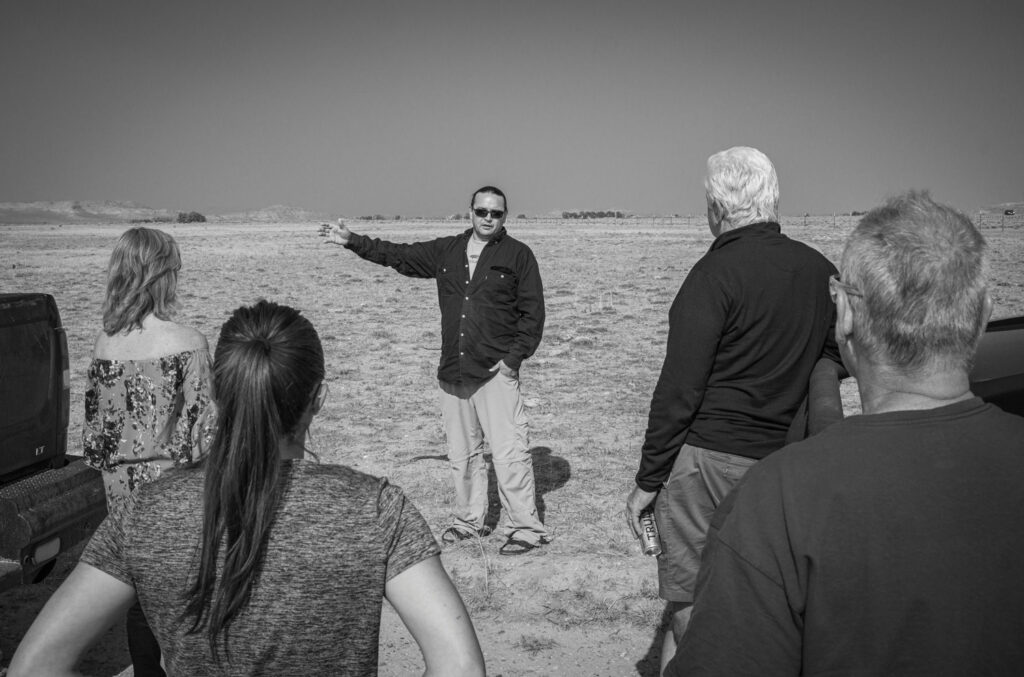
Jason Baldes explains the cultural importance of restoring buffalo to Eastern Shoshone tribal lands to curious neighbors and friends at the tribe’s bison paddock on the Wind River Reservation in Wyoming. Photo by Russel Albert Daniels/High Country News
“THE NOTION OF WILD, the notion of wilderness, ‘untrammeled by man,’ ‘leave no trace’ — those are foreign concepts to Native people,” Baldes told me last August, leaning back on a couch with a buffalo hide at his feet, one arm resting behind his head and the other gesturing slowly. Baldes is quiet and charismatic, moving nimbly across bodies of knowledge. He often speaks uninterrupted for several minutes at a time, weaving together ecology (“nephelometric turbidity units”), public policy (the Clean Water Act), and U.S. history (the General Allotment Act of 1887). Baldes doesn’t simply talk; more like a river, he holds forth.
At the center of these overlapping ideas is the conviction that addressing the contemporary needs of Native America must start with the land. When Baldes speaks of buffalo as wildlife, he calls on an opposite vision from the principles underpinning wild horse management.
In the past 50 years, wild horses slipped between the definitional cracks that separate wildlife from livestock. They cannot be hunted like elk or slaughtered like cattle. They have come to stand apart from every other animal in the West. In their idealized state, in the eyes of their vocal defenders, they live with minimal interaction with humanity, opposite the world of society.
This vision of American wildness grew up with urban industrialism, made possible by the false notion of an empty continent. Baldes alluded to the 1964 Wilderness Act, which legally defines wilderness as a place “untrammeled by man.”
“That’s a notion that was brought by settlers and Europeans,” Baldes explained. It emerged from the collective colonial erasure that was only made possible by the forced removal of American Indians onto reservations.
For Baldes, “wilderness” and “wild” mean something else: The goal is not to treat buffalo as ornaments in an untouched landscape; it’s to re-establish an intimate relationship of human-animal dependence. “The salmon people are salmon people for a reason. The rice people are rice people for a reason.” He slipped into the past tense: “The buffalo people were buffalo people for a reason.”
On a bright summer morning, Baldes pulled off the highway at an unmarked turnout on U.S. 26 and opened the padlock on a tall livestock gate. A caravan of 10 visitors followed him, including several elder statesmen of Wyoming conservation — a former head of the Wyoming Wildlife Federation, the former president of the National Wildlife Federation, and Jason’s father, Richard Baldes, who is credited with establishing the Wind River Reservation’s first game code in the 1980s, after a bitter political and legal battle.
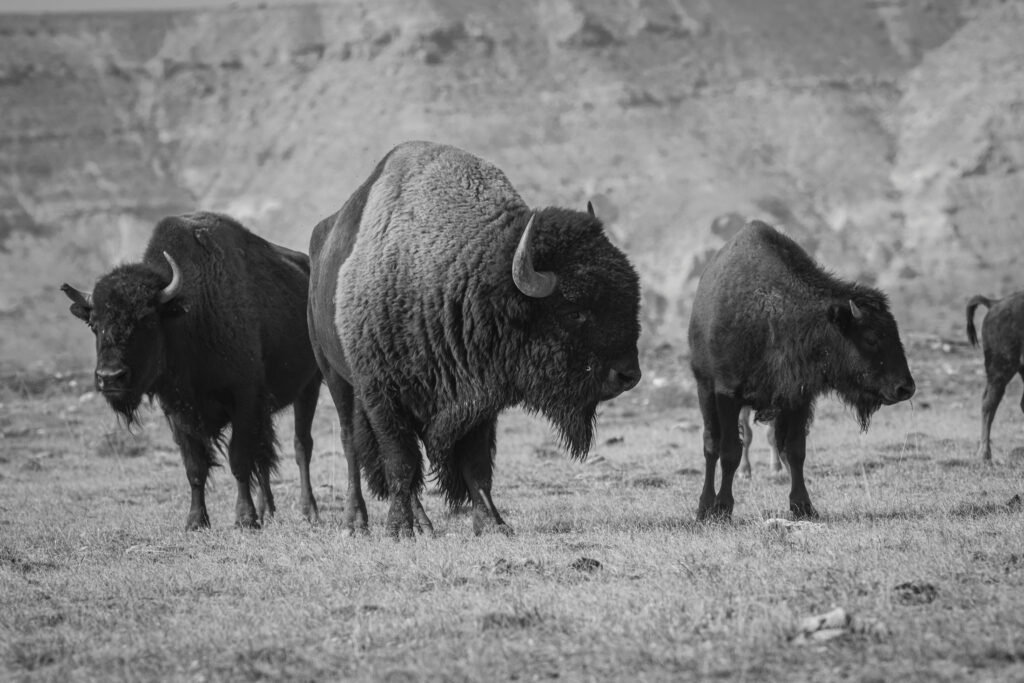
Buffalo on the Eastern Shoshone Tribe’s reclaimed property on the Wind River Reservation. The herd is part of a national effort to restore wild buffalo to tribal lands across the West. Photo by Russel Albert Daniels/High Country News
The trucks and SUVs turned onto a ranch road, crossing an irrigated pasture. They drove ahead, down a steep grade, through a low creek, and back up onto a flat meadow. The road drew parallel with a 5-foot-tall fence, with six wire strands instead of the typical four. “It’s above and beyond what would be required,” Baldes explained, “so that we can appease the opponents” — those who resist buffalo reintroduction. To the left, the Wind River flowed in braids, 100 feet below the escarpment upon which they drove. On the opposite shore, the foothills of the Wind River Mountains rose and then faded into sepia behind the summer wildfire haze.
Forty buffalo watched indifferently as the visitors approached in their vehicles. The herd moved like honey in the thickening midday heat. A lone magpie perched atop one of the bulls, whose gangly hind legs cut a stark contrast to the rest of its body. Already the largest land animals in North America, they seemed even bigger with their two-tone fleece coats that covered only their front halves.
Baldes, leading the caravan in his pickup, stopped less than a stone’s throw from the nearest cow and her calf. The calf moved toward Baldes’ truck. Her bright black eyes were fixed and curious, framed by scraggly fibers. She ventured closer with deliberate steps while her mother craned her neck to look on from behind.
Baldes put his hand out of the window. The calf raised her nose and met it with a lick. Her curiosity satisfied, she returned to her mother. It was only the second time Baldes had touched a living buffalo since the herd first arrived on the reservation in 2016.
For Baldes, a key principle of the restoration effort is maintaining the genetic integrity of the descendants of approximately a hundred animals that survived a population bottleneck at the beginning of the 20th century. Back then, it became common practice for ranchers to crossbreed buffalo with cattle, with the intent of making buffalo hardier, more disease resistant and better suited to life on a cattle ranch. Today, there are more than 400,000 buffalo in the U.S. More than 90% of them are ranch livestock; just 30,000 are managed as wildlife in “conservation herds.” Of these, only about 10,000 are free of domestic cattle genes.
Baldes’ insistence on maintaining buffalo without cattle DNA dovetails with his and Patti’s broader vision for decolonizing tribal lands and livelihoods. The way Jason sees it, buffalo with cattle genetics bear the mark of colonialism. “We’re one of the few reservations where we can really subsist, if we want to, off of our wildlife species,” Jason explained. He held a travel-style coffee mug with a sticker that read “sick of the good old boys.” It’s clear that the hunt itself is only incidental to the Baldeses’ vision. Their larger objective is to have buffalo written into the tribal game code and allowed to roam freely on tribal trust land, where they could once again form the cornerstone of Shoshone and Arapaho livelihoods. “That’s a change in paradigm from what was brought colonially, what they assimilated us to be,” Jason explained. “It’s cultural revitalization in a contemporary context: land rematriation through buffalo restoration.”
For that reason, the encounter with the buffalo calf was bittersweet. In five years on the reservation, the buffalo herds have come to regard humans without fear. Since 2016, they’ve only known predators on two occasions. Both times, Baldes was there.
“It’s cultural revitalization in a contemporary context: land rematriation through buffalo restoration.”
In 2019, he shot the first buffalo killed on the reservation in generations. The harvest was accompanied by a community event and a ceremony, and the meat was distributed among tribal members. Today, the skull sits on an outdoor shelf at his home. But Baldes speaks ambivalently about that first harvest: “It didn’t feel quite right, because they’re not on the landscape,” he said. Confined in a 300-acre pasture, the buffalo were still living like European livestock. “When we’ve got them managed as wildlife and we go out and we hunt them? We find one and we make a sneak and we harvest it in the field? That’s when it’ll be right.” When that time comes, buffalo calves will no longer sidle up to vehicles.
Back at the house, Baldes gestured west, beyond the buffalo enclosure, across the Wind River, to the miles of sagebrush steppe unfolding in the distance. He explained that those 70,000 acres — the crescent-shaped range bounded by two highways and two rivers — could become the largest patch of tribal land in the nation where genetically intact buffalo are managed as wildlife. That’s the interim target. He added, “We’ve got hundreds of thousands of acres, not only in the Wind Rivers but also the Owl Creeks.” The Owl Creek Mountains lie just to the north, looking like hills besides the glaciated peaks of the Winds. “They should never have to be in a gated corral again.”
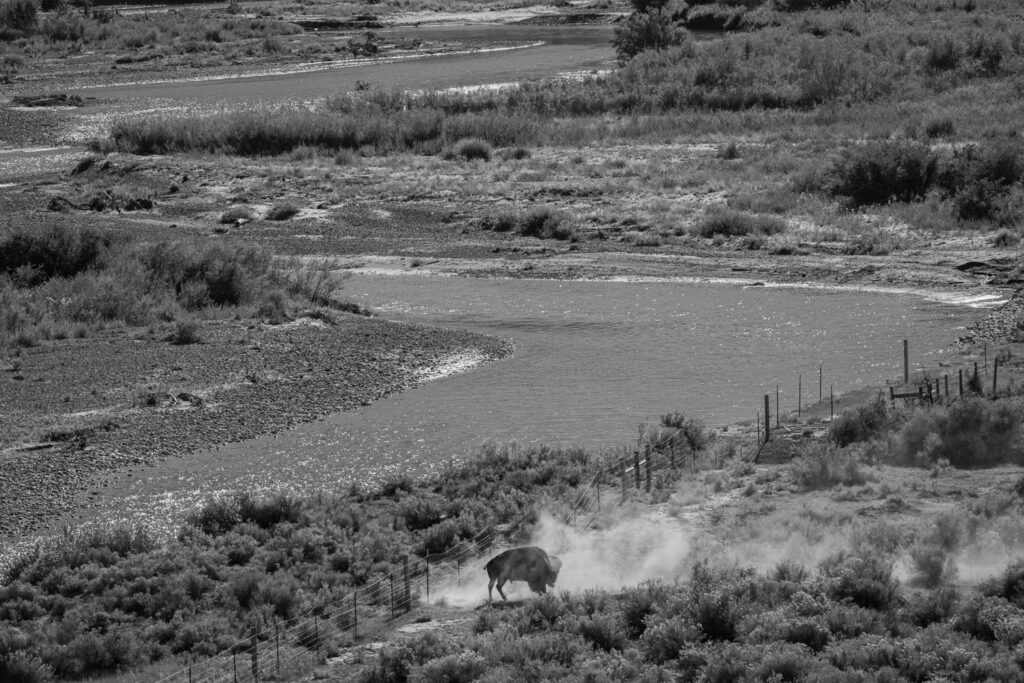
A lone buffalo shakes itself after a dust bath along the banks of the Wind River.
Photo by Russel Albert Daniels/High Country News
REN FREEMAN is an Eastern Shoshone anthropologist who grew up on the Wind River Reservation in Fort Washakie, “just across the hill” from Baldes. Today, she lives in western Montana, where she directs the Indigenous Research Center at Salish Kootenai College, leads the Intercontinental American Indigenous Research Association, and is a professor of anthropology and Native studies at the University of Montana and Salish Kootenai College. Although they live hundreds of miles apart, she and Baldes often cross paths in their work, serving on the same committees and presenting at the same conferences.
In conversations with Freeman, the ecological and cultural distinctions between horses and buffalo are blurred at the edges: native/invasive, wild/domestic, European/Indigenous. When explaining the details of her work, she often pauses to ask a careful question of nobody in particular, like a rhetorical checkpoint, before providing the answer. It’s easy to imagine her at the front of a classroom.
“Wild horses and buffalo share a lot of the social-economic-political journey in this country, and when you overlay that with the plight of Indigenous people, you get this triad.” To Freeman, this relationship between horses, buffalo, and humans began in the Pleistocene, when buffalo and horses both roamed freely across North America. The ancient American horse may not have been domesticated — it was likely on the menu of many societies — but Freeman maintains that horses were nevertheless an important part of some early American cultures: “We were always in relationship with horses.” For that reason, she takes issue with those who dismiss wild horses as feral or invasive. Horses, along with buffalo, should both be considered “native natural wildlife,” says Freeman. “It has only been the politicizing of their history and existence that has placed them in a different category.”
Part of that politicizing, she explains, comes from the idea that horses’ wildness places them apart from human culture. She described her relationship with the reservation’s wild horses with a sense of mutual recognition: “I’m not wild to you; you’re not wild to me.”
Freeman frequently finds herself defending, in her terms, wild horses’ right to exist, especially to those, like Baldes, who are apt to call the animals feral or invasive. She asked, almost rhetorically, “Why can’t we let 1,000 bison mingle and live with 14,000 wild horses?” In these existential politics, she sees parallels to her own Indigenous history. “What has happened to them” — wild horses — “has happened to us.” Ranchers and farmers acquired more land, while the disempowered, human and nonhuman, were pushed to the margins.
“Wild horses and buffalo share a lot of the social-economic-political journey in this country, and when you overlay that with the plight of Indigenous people, you get this triad.”
The solution, in Freeman’s view, is to let go of the expectation that every inhabitant of the landscape justify its right to exist. She rejects the notion of a survivalist competition between human and animal lives. “It’s similar to our being Indigenous peoples, who share the worldview of relationality and interdependence with nonhuman beings — whether it’s animals, plants, rocks, the sky.” The alternative, Freeman said, is to reconceive management altogether.
Here, Freeman and Baldes agree. This redefinition must start by untangling the idea of management — and its counterpart, wildness — from ideals of dominance and control. “Our land-use change is a shift from a colonial paradigm of agriculture and livestock to that of ecological integrity,” Baldes said. In concrete terms, this redefinition looks like those two days in 2019, when a dozen Arapaho buffalo shared 70,000 acres of tribal land with domesticated cattle, wild horses and humans. In that moment, the wild, the tame, the social and the feral coexisted without objection to each other. The land was for all of them.
Ultimately, the disagreements over whether horses are wild or feral, or whether buffalo can coexist with cattle, seem trivial. Even the details about game codes and herd management are almost ancillary. Buffalo and horses both serve as living reminders that Western landscapes do not have to be divided between the wild and the tame. Before colonization, humans and nonhumans shared an undivided claim to the land. According to Baldes and Freeman, they still could.
“Buffalo was the foundation for everything, at one time, for our grandmas and grandpas,” Baldes told me. “In a contemporary setting, it can be that way again. Especially here at Wind River, where we have the habitat to actually allow them to exist as the One Above intended. Putting pieces of that puzzle back heals the land. In turn, it will heal our communities. It will heal our families and heal us individually.”
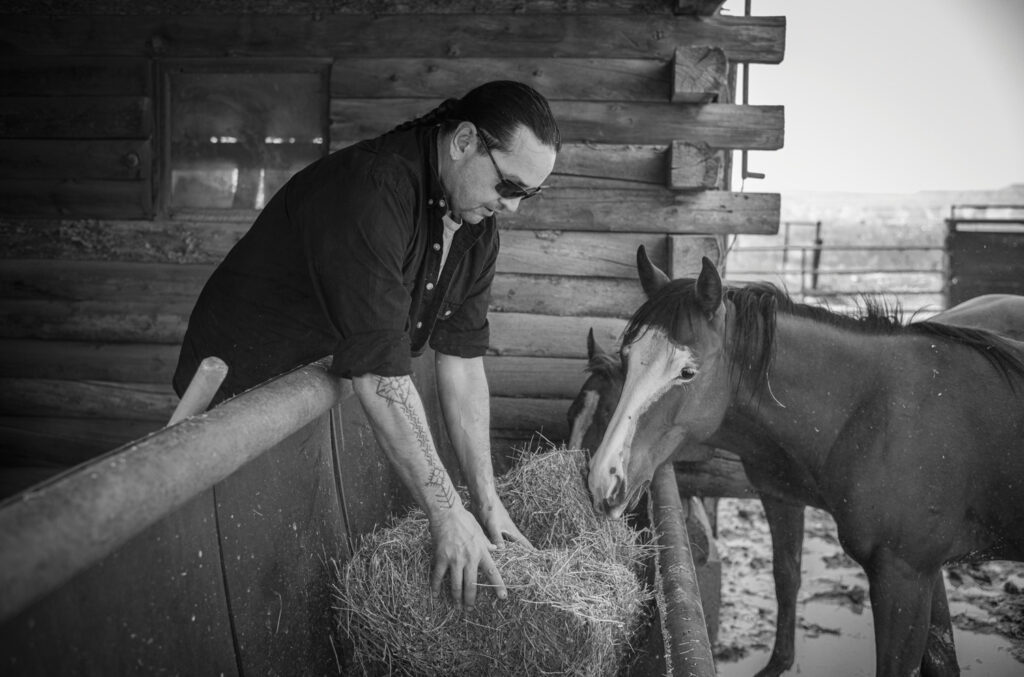
Jason Baldes feeds his horses at his home in Morton, Wyoming. Baldes, a member of the Eastern Shoshone Tribe, and his wife, Patti Baldes, a member of the Northern Arapaho Tribe, manage bison herds on the Wind River Indian Reservation. Photo by Russel Albert Daniels/High Country News
ON A HOT SATURDAY AFTERNOON, Jason Baldes, his dog, Willi, and a friend called Dude, sat in the shade of a horse trailer, waiting for Patti to arrive with the truck.
Baldes’ horses, about 30 of them, trickled in from their pasture to a corral baited with four bales of hay. Wearing a straw hat and black Birkenstocks, Baldes seemed as unhurried as they did. “That’s all training a horse really is: negotiation.” He added, “I don’t ‘break’ anything.”
The conversation turned to wild horses. Someday, if Jason and Patti are successful, wild horses and buffalo will share the same open range. Baldes admitted he didn’t have a simple solution to the question of population control. “I don’t want to go out and shoot a horse and eat it,” he said, sitting next to his own small herd. “Not unless I’m starving” — a horse brayed — “and I had to. But why eat horse when we have elk, deer, antelope?” He paused. “Buffalo.”
Willi took a turn darting around the horses’ legs before returning to the shade to grin and pant. The grass around us was lush after the recent rain, August be damned.
By now, most of the horses had wandered into the corral, but a dozen still stood on the opposite side of the fence. They regarded each other through the metal crossbars. Time passed. Dude snored in a lawn chair.
At some point, our water bottles ran empty. It was a two-minute drive and three left turns to Sacagawea Cemetery, where we filled our bottles from a spigot mounted on a pipe sprouting from the bare ground beside the asphalt parking strip. The water came out cold and rich and perfect, as Baldes said it would. Two more minutes and three right turns and we were back in the shade.
The conversation, as languid as the afternoon, drifted to grizzly bears, a recent mauling in Yellowstone. At one point, Baldes lit up. “Did you see? There’s a pretty good article that came out in Canada. …” It was published a few weeks prior in the peer-reviewed journal Ecology & Society. Baldes explained how the researchers sampled the genetic diversity of grizzly bears in coastal British Columbia, finding three distinct groups. When they mapped the grizzly genetics, they found that each group of bears corresponded to one of the three Indigenous language groups of that same area (Salishan, Tsimshian and Wakashan).
Dude, no longer asleep, chimed in. “You said they’re your relatives, right?”
“Yeah,” Baldes replied. “We say, ‘All my relations.’” He repeated it three times. First in Lakota, “Mitákuye Oyás’iŋ,” then in Arapaho, “Beisiihi’ Neito’eino’,” and finally in Shoshone, “dumuh nahrewuruh.” “It’s very simple, but significant, because it’s referring to all life. The bears, the wolves, the buffalo, the elk, the deer — all four-leggeds, all winged ones. All of life.”
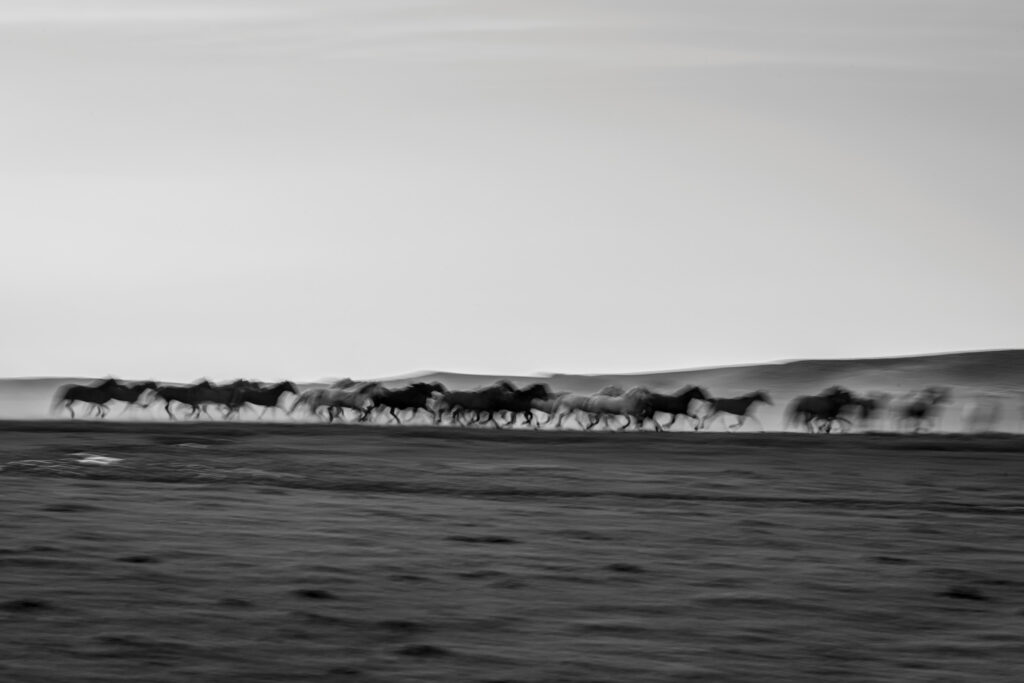
A large horse herd at the Wind River Wild Horse Sanctuary in Lander, Wyoming, on the Wind River Reservation. Photo by Russel Albert Daniels/High Country News
This article was originally published by Stephen Lezak of High Country News on December 1, 2021. The featured image is of Jason Baldes, a member of the Eastern Shoshone Tribe, and his dog, Willi, in Morton, Wyoming, on the Wind River Indian Reservation. Photo by Russel Albert Daniels/High Country News.

